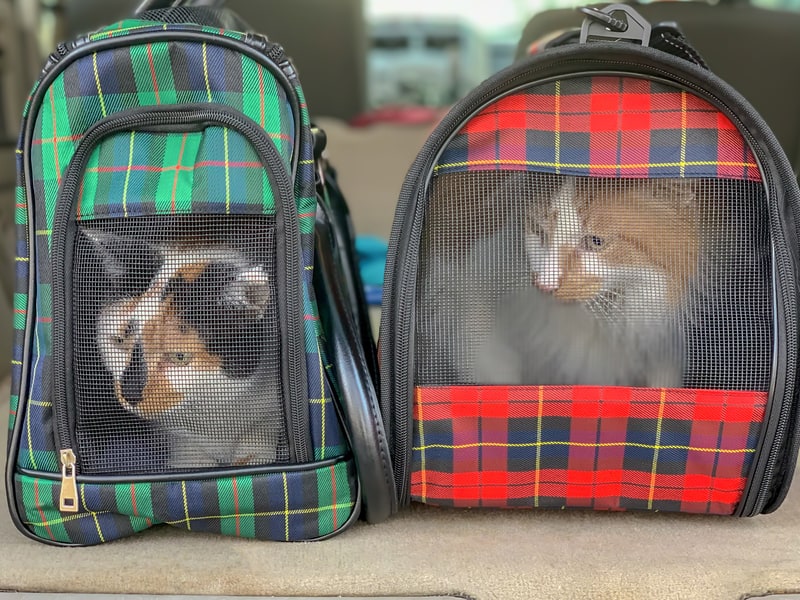My Pet World: Traveling with cats takes advance preparation
And more answers on living with and loving our pets

Animal expert Cathy M. Rosenthal offers pet advice on moving and traveling with with cats in a car – plus two dogs – and on the dangers of cat bites.
Traveling with cats in a car
Dear Cathy: We’re moving to Wyoming from Arizona and have two cats and two dogs. It will be a two-day drive and I am concerned about the cats. First, I don’t know if a hotel would let us stay having four animals, and second, I am afraid that the cats will get loose, freak out or something else.
I can’t put them together because they don’t like each other and then there’s the issue of relieving themselves and feeding and watering them. We will be in the car for eight to 10 hours each day. I have cat carriers, but wouldn’t they be cramped for that long? And how do I feed them and give them water? And then I’m afraid of letting them out in the hotel room.
Should I try to find a kennel who will board them for the one night we will have to stop? I think a sedative in their food might help if I can get them to eat. My car is a Camry so there’s not a lot of room for a larger kennel either. Do you have any advice?
– Sue, Chino Valley, Arizona
Dear Sue: I can tell you are anxious about this trip but give you kudos for moving with your pets. Moving with pets is doable with advanced planning. Begin by calling hotels or search home rentals like Airbnb to find places that accept pets. Then let them know you are moving and how many pets you are bringing. There may be a per pet charge fee, regardless of where you stay, or a pet limit (most limit to two pets only).
If there is a pet limit, you have three options. The first option is to ask the hotel or Airbnb host for permission to exceed their limit. Get this permission in writing before you set out on your trip.
Option two is to rent two hotel rooms so you can be within the pet limits per room. Paying for two hotel adjoining rooms (or a two-bedroom home rental) also gives you more options for separating the animals that don’t get along.
Option three is to place them at a local kennel overnight. You would need to arrive before they close at the end of the day, so plan the drive accordingly.
Send vaccination verification to the kennel in advance of your arrival and be sure to carry copies in case of an emergency. The kennel option also gives you a little time to yourself after a long day and less worry about who doesn’t get along with whom.
Read more: The overlooked costs of pet ownership
The cats are fine traveling in their carriers as long as they can stand up and turn around in it. In fact, it’s the safest place they can be. I understand your worry about the cats bolting out of the car.
They are probably not going to eat during the day, but you can let them out inside the car if you need to give them water or access to the litter box. If you let them out in the car for any reason, stay inside the vehicle with them so you don’t have to open a door, and make sure all doors and windows remain closed until they are safely back in their carriers. Wait to feed them when you get to your overnight destination.
Talk to your vet about getting medication to help them rest easier. Oftentimes though, the hum of the car on the road puts most pets to sleep. Play some soundscape or spa-like music to help all of you relax.
Finally, make sure everyone has a microchip as well as collar and tag with your cell phone number. Safe travels.
Cat bite fever
Dear Cathy: You wrote an interesting piece on cat bites. But I think you should mention that a cat bite that punctures the skin is a medical emergency. I ended up in the emergency room a few years ago after being bitten in my calf by a cat.
I am told that cat bites are more dangerous than dog bites because of the bacteria in a cat’s mouth, and the depth that their sharp teeth can go when they bite. It’s worth a mention because most people don’t know.
– Terry, Rockville Centre, New York
Dear Terry: You are correct. Even a mild cat bite can present with more infection if left untreated because of the bacteria in a cat’s mouth. Regardless of severity, if a cat breaks your skin with its teeth, then the bite needs to be checked out by a doctor.
Cathy M. Rosenthal is a longtime animal advocate, author, columnist, and pet expert who has more than 25 years in the animal welfare field. Send your pet questions, stories, and tips to cathy@petpundit.com. Please include your name, city, and state. You can follow her @cathymrosenthal.
© Tribune Content Agency, LLC.


